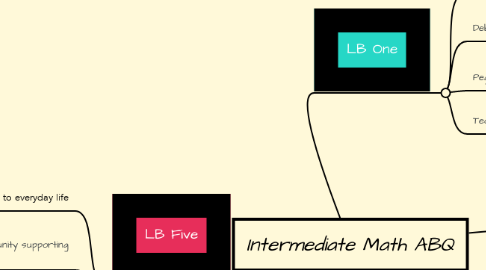
1. LB One
1.1. Dan Meyer
1.1.1. Teaching students math skills not formulas (ex. perseverance & problem solving),
1.2. Deborah Ball
1.2.1. being a knowledgable teacher (knowing about math and in turn being able to understand student's thinking)
1.3. Peg Smith
1.3.1. Anticipating student responses, monitoring, selecting, sequencing, connecting
1.4. Technology in math class
1.4.1. CLIPS, National Library of Virtual Manipulatives
2. LB Five
2.1. Connecting Math to everyday life
2.1.1. Costs
2.1.2. Budgets
2.2. Importance of a community supporting the math learner
2.2.1. Keep parents in the loop and encourage math outside of school
2.3. Closing the gap at the intermediate level
3. LB Four
3.1. Differentiated Instruction
3.1.1. Jo Boaler & Railside School example
3.1.1.1. Using mixed groupings "group worthy tasks"
3.1.2. Knowing the learning styles of your students
3.1.3. Three part lesson plans & teaching through problem solving
3.1.4. Creating a level playing field for all students (ex. EQAO providing formula sheets)
4. LB Two
4.1. Not assuming prior knowledge
4.2. Orchestrating productive conversations about math concepts/ideas (ex. equals sign)
4.3. Randall Charles
4.3.1. BIG math ideas
4.4. Proportional Reasoning
5. LB Three
5.1. The Adolescent Learner
5.1.1. Intellectual, Physical, Emotional, Social changes affecting development and trickling affects into the classroom
5.2. Catering to the needs of the adolescent learner in math
5.2.1. Can't sit for as long (cartilage hardening), more likely to questioning etc.
5.2.2. Effective questioning to create an inclusive and safe learning space that encourages higher level thinking
5.2.3. Assessing in a variety of ways including through observation/conferencing (for, as, of)

